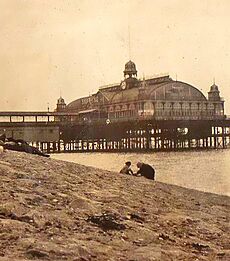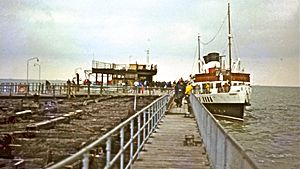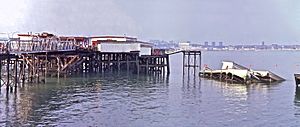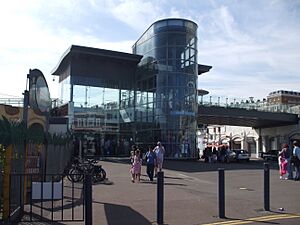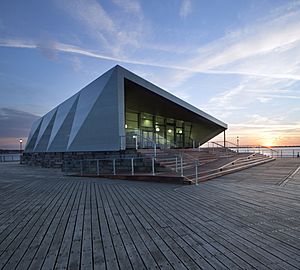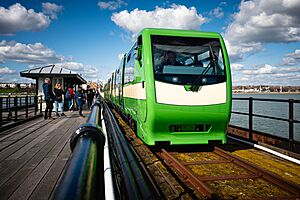Southend Pier facts for kids
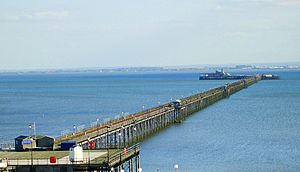
Southend Pier in 2007
|
|
| Type | Pleasure, RNLI lifeboat station |
|---|---|
| Carries | Pedestrians, shuttle train, lifeboat crews/supplies |
| Spans | Thames Estuary |
| Locale | Essex, UK |
| Maintained by | Southend-on-Sea City Council |
| Construction | Hardwood decking on iron piles |
| Owner | Southend-on-Sea City Council |
| Total length | 2,158 metres (7,080 ft) |
| Opening date | 1830 (Iron pier, 1889) |
| Coordinates | TQ884849 (shoreside) TQ897830 (pierhead) |

Southend-on-Sea district map
|
|
| Southend Pier Act 1829 | |
|---|---|
| Act of Parliament | |
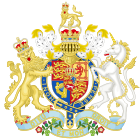
|
|
| Citation | 10 Geo. 4. c. xlix |
| Dates | |
| Royal assent | 14 May 1829 |
| Other legislation | |
| Repealed by | Essex Act 1987 |
|
Status: Repealed
|
|
| Text of statute as originally enacted | |
Southend Pier is a famous landmark in Southend-on-Sea, England. It stretches 1.33 miles (2.14 km) into the Thames Estuary, making it the longest pleasure pier in the world. A law to build the pier was approved in May 1829, and construction began in July 1829. The original wooden pier was later replaced by an iron pier, which opened in August 1889. The Southend Pier Railway, which started in the early 1890s, was the first railway ever built on a pier.
The pier played an important role during both World War I and World War II. For example, during World War II, the Royal Navy took over the pier and renamed it HMS Leigh. It was closed to the public in September 1939. After the war, in 1949, about six million people visited the pier. New attractions opened in the 1950s. However, the pier started to decline in the 1970s, and there were plans to close it in 1980. After many protests, the pier stayed open. In 1983, a grant helped pay for repairs, and a new pier railway opened in May 1986. Princess Anne officially opened it.
The pier has had several fires over the years, including big ones in 1959, 1976, 1995, and 2005. The 1976 fire was followed by another one a year later. These fires happened when the pier was already struggling, and the railway had to close. In 1995, a fire caused a lot of damage, and parts of the pier had to be rebuilt. Just ten years later, in 2005, another fire destroyed much of the wooden walkway and damaged the old pierhead.
Sir John Betjeman, a famous English poet, once said, "the Pier is Southend, Southend is the Pier." This shows how important the pier is to the town. The pier is also a Grade II listed building, meaning it's a historically important structure.
History of Southend Pier
Why the Pier Was Built
Seaside towns became very popular for holidays in the late 1700s. By the early 1800s, Southend was growing as a holiday spot. People believed that being by the sea was good for their health. Many Londoners came to Southend because it was close to the capital.
However, visitors often arrived by sailing boat or later by Thames steamer. Boats could only dock when the tide was high. The coast at Southend has long mudflats that stretch far from the shore. Even at high tide, the water isn't very deep. Large boats couldn't get close to the beach, and no boats could reach the shore at low tide. This meant many visitors went to other resorts like Margate that had better places for boats to stop.
To fix this problem, local leaders wanted a pier built. This pier would allow boats to reach Southend at all times, no matter the tide. Sir William Heygate, a former Lord Mayor of London, led the effort. People were very excited when the law to build the pier was passed.
Early Days of the Pier
The First Wooden Pier
In the late 1820s, a plan to build a pier was approved by the government. On May 14, 1829, the Southend Pier Act 1829 became law. Just over two months later, on July 25, the foundation stone for the first part of the pier was laid. By June 1830, a 180-metre (590 ft) wooden pier was open. It was built using about 90 oak trees.
The pier was made longer around 1834 and again in 1846. It eventually stretched over a mile. By 1848, it was the longest pier in Europe, at 2,100 metres (7,000 ft). The first owners sold it in 1846 because they had money problems.
The Iron Pier
By the 1850s, the London, Tilbury and Southend Railway reached Southend. This brought many more visitors from east London. All these visitors caused wear and tear on the wooden pier. In 1875, the pier was sold to the local council. In 1887, the council decided to build a new iron pier next to the old wooden one. Some wood from the old pier was even used to make a new mayoral chair in 1892.
The new pier was designed by James Brunlees. He had also designed Southport Pier, the first iron pier in England. Work on the new pier began in early 1887. It opened to the public in August 1889. It cost about £68,920 to build. A single-track electric railway started running the next year. It was the first pier railway in the country. The pier was extended again in 1897.
In 1903, reports showed that about 1 million people paid to use the pier that year. Also, 250,000 passengers arrived by pleasure boats. An upper deck with a bandstand and shops opened in 1908. Later that year, on November 23, a ship broke free and crashed into the pier. It left a large hole and caused a lot of damage.
War Years and Between the Wars
During the early part of World War I, three prison ships were kept near the pier. The first ship held German soldiers, and the others held mostly civilians. Prisoners would walk along the high street and the pier to get to the ships. The British Admiralty, which was in charge of the navy, paid for a signal station at the pierhead. However, the pier still stayed open for fun. In the spring of 1915, the prisoners were moved to other camps for safety.
After World War I, Southend Pier became very popular. More facilities were needed for boats to dock. The pier was extended in 1927. This 99 metres (326 ft) extension cost £58,000. It was officially opened on July 8, 1929, by the Duke of Kent. This extension, called the Prince George Extension, allowed more steamers to visit the pier.
On July 23, 1935, Southend Pier celebrated its 100th anniversary. A bronze plaque was put on the pierhead. The celebration was held in 1935 because that's when the British Admiralty started showing Southend Pier on their navigation maps.
Wartime Operations
During World War II, the Royal Navy took over Southend Pier. It was renamed HMS Leigh and closed to the public on September 9, 1939. It became the main control center for ships in the Thames Estuary. On November 22, 1939, a German air raid lasted 90 minutes, but the pier's defenders kept them away.
The pier was a meeting point for 3,367 convoys during the war. It used large barrage balloons to protect ships from dive bombers. Out of over 84,000 ships that passed Southend, only one was lost. This was the SS Richard Montgomery, which sank in August 1944. It contained over 1,500 tons of explosives. Parts of the ship can still be seen at low tide.
After the War
After World War II, the pier reopened to visitors. In 1949, almost six million people visited, which was more than before the war. The pier railway trains were replaced in 1949 with new ones, similar to those on the London Underground. About 5 million passengers rode the railway in its first year after reopening. In the 1950s, more attractions opened on the pier, like the Dolphin Café and a Hall of Mirrors. In 1959, a fire destroyed the pavilion near the shore. Over 500 people were trapped on the other side of the fire and had to be rescued by boat. A ten-pin bowling alley replaced the pavilion in 1962.
Decline and Recovery
Over time, fewer people used the pier, and its structure started to wear out. In 1971, an injury to a child led to a survey. This resulted in repairs and replacements for much of the pier railway. In 1976, a fire destroyed a large part of the 1908 pierhead. Firefighters had trouble getting enough water to fight the blaze. The cause of the fire was never officially known, but a discarded cigarette was thought to be likely. In November 1977, another fire badly damaged the bowling alley. In October 1978, the pier railway closed due to safety worries. By this time, many British holidaymakers were choosing to go on package holidays abroad.
In 1980, the council announced plans to close the pier. After protests, the pier stayed open while a solution was found. In 1983, things changed when money was given for big repairs. The repair work started in 1984 and finished in May 1986. Princess Anne officially opened the new pier railway. The two new trains were named after Sir John Betjeman and Sir William Heygate. The total cost of repairs was about £1.5 million.
On June 30, 1986, a 54.9-metre (180 ft) tanker ship crashed into the pier. It broke a 21.3-metre (70 ft) gap in the new pierhead. It also destroyed the boathouse used by the lifeboat service. A temporary bridge was built to allow access, but full repairs weren't finished until 1989.
Fires and Rebuilding
On June 7, 1995, an electrical problem caused a fire in the bowling alley. The fire quickly spread through the wooden roof and to the railway station. It took two hours to get it under control. The railway track was damaged, but the trains were safe. Repairs cost about £680,000. The fire also damaged the wooden walkway and its supports. This required six months of rebuilding in 1998.
In the summer of 1999, the former pirate radio station Radio Caroline parked its radio ship, Ross Revenge, at the pier-head for about a month. They broadcast legally to the local area for 28 days. When a power cut left the pier without electricity for two days, Radio Caroline provided power from their ship. This allowed shops and attractions to keep working until the main power was back.
The 21st Century at Southend Pier
Southend Council invested money in the pier in the 2000s to make it a popular place to visit again. The "S-SHAPE" project helped get funding for improvements.
The pierhead was greatly improved between 2000 and 2001. A new lifeboat station was built with the RNLI. Much of the £500,000 cost came from a gift left by a yachtsman named Peter Royal. The new station is made of glass and looks very modern. It also has the Southend Pier Museum and a gift shop about the RNLI. The museum shows exhibits about the pier's history, including a restored signal box, old train carriages, photos, and old penny slot machines.
In 2003, the part of the pier closest to the shore was redeveloped. A new steel and glass entrance was built. This modern design caused some discussion because it looked very different from the old Victorian pier. A new pier bridge was also built higher up. This was to stop tall vehicles, like double-decker buses, from getting stuck underneath. A visitor and tourist information center opened in 2004, along with a new lift to make it easier to get to the information center and the pier railway.
The 2005 Fire
On October 9, 2005, a fire badly damaged much of the pierhead. This included the railway station, a pub, and several shops. The fire was thought to have started in McGinty's Bar around 9:10 PM. Because of where it started and how much damage there was, the exact cause was never officially found, but it was thought to be an accident. No one was hurt. Firefighters had trouble putting out the fire because the pumps on the pier didn't work. The Southend lifeboat helped by taking the first firefighters to the scene.
Most of the wooden walkway was destroyed, but the main iron structure was mostly fine. The Pier Railway tracks bent from the intense heat. The fire service report said that if there had been a sprinkler system, the fire could have been put out quickly. Also, there were no fire alarms in much of the pier, so firefighters were called up to 90 minutes later than they could have been.
The pier reopened to the public on December 1, 2005. In 2007, it was voted 'Pier of the Year'.
Cultural Centre
On September 15, 2009, Southend Borough Council announced the winner of a design competition for a new pierhead building. A Swedish architecture firm, White, won with their design called Sculpted by Wind and Wave. This design was chosen from 73 entries from around the world.
On May 17, 2012, the structure for a new Pier Pavilion was put onto the pier. It opened to the public on July 21. It is used as a theatre and for art exhibitions, and can hold up to 185 people. Some of the old pier timber was even used to build beach huts on Shoebury's East Beach in 2013.
Southend Pier Railway
The pier railway runs along the entire length of Southend Pier. It carries passengers from the shore to the pierhead. It runs every day the pier is open, usually every 15 or 30 minutes.
The first wooden pier, built in 1830, had a horse tramway from 1846. This was used to carry goods and visitors to the pierhead. In 1890, when the iron pier was built, an electric tramway was installed. It ran the full length of the pier by 1891. In 1949, the old trains were replaced with new ones that looked similar to those used on the London Underground.
In October 1978, the electric railway closed because it was old and needed expensive repairs. It reopened on May 2, 1986, with two new diesel trains. The track was simpler, with just one line and a place for trains to pass each other. The pierhead station was moved temporarily after the 2005 fire. A new, modern station opened in its original spot in September 2009.
Southend Lifeboat Station
One of the two boathouses for the Southend-on-Sea lifeboat station is located at the pierhead of Southend Pier. It holds an B-class (Atlantic 85) Inshore lifeboat and a smaller D-class (IB1) lifeboat. Both are launched into the deep water next to the pier using special cranes called davits. The boathouse is a modern building. It has rooms for the crew, offices, an RNLI shop, and a viewing area where visitors can see the lifeboats. There's also a sun deck on top that the public can use. Lifeboat crews use an electric buggy with sirens and flashing lights to travel along the pier from the shore to the boathouse.
A lifeboat has been based at the pier since 1879. At first, lifeboats were launched using davits, just like today. However, in 1935, a new lifeboat house was built at the pierhead. It had a slipway to launch the lifeboat. This building was used until 1986, when a ship crashed into the pier and destroyed the boathouse. A temporary boathouse was used until 2002, when the current modern boathouse opened.


